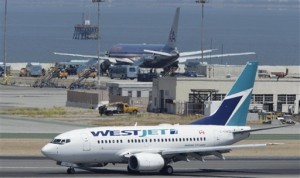A hijack threat halted an American Airlines flight just before takeoff Thursday, leaving the New York-bound jet sitting on the tarmac for several hours while it was searched and passengers were removed for extra scrutiny.
The FBI later determined that the telephoned threat wasn’t credible, but in the wake of the 9/11 attacks and a series of airline scares in the past year, the incident still rattled nerves as it played out live on national TV.
Police were investigating who called in the hijacking threat and what their motivation might have been.

Although passengers described the scene aboard the Boeing 767 headed to John F. Kennedy International Airport as calm, witnesses said a man and a woman sitting in the back row were taken off in handcuffs. But they were quickly released and allowed to rebook their flights.
The couple confirmed to an Associated Press reporter that they were the ones who had been removed from the plane but declined to identify themselves. They said authorities explained they were picked at random for questioning.
But a fellow passenger suggested the couple may have been targeted because of their appearance. Michael Anderson, 20, saw the couple at the American Airlines ticket counter after all the passengers were let off the detained plane and observed them carrying passports from Pakistan.
“It definitely seems like it was racial profiling, based on what they look like physically and the fact they are Pakistani. It seems like this was a false accusation,” said Anderson, a Yale University sophomore who was heading back to school.
American Airlines Flight 24, with 163 passengers and a crew of 11, was already running 2 1/2 hours late when it pulled away from the gate at 10 a.m. Minutes later, it was being dispatched to a remote stretch of tarmac at San Francisco International Airport where it sat for two hours.
“There was no fear in the cabin at all,” passenger Michael Kidd told the AP. “It was pretty calm. Even with the frustration of having to sit there, there were no raised voices.”
Passengers with Internet access searched the Web for details about the incident. Passengers were allowed to go to the bathroom one at a time, Kidd said, with flight attendants admonishing anyone who tried to get to their overhead luggage.
Police eventually entered through the back door and escorted the two passengers into a police car.
Others on board were taken off the plane six at a time and greeted by San Francisco Police Department officers who used security wands to screen them and their carry-on luggage. They were then taken by buses to a terminal for further security checks and to rebook their flights.
“The two passengers were taken off the plane separately, but we cannot discuss the specifics why,” said FBI spokesman Joseph Schadler.
The couple declined to discuss the possibility that they may have been targeted because of their appearance, but said they were treated well and only questioned briefly before they were allowed to go to the ticket counter like all the other passengers.
“Of course we’re upset, but I guess we can’t blame them,” the woman told the AP. “They’re just doing their job.”
Kidd said he and his wife did not believe the couple had been racially profiled based on appearances alone. The man wore a Los Angeles Lakers jersey and the woman was wearing a beret, and they looked like typical Californians, he said.
The threat report originated from clerk at a business in Alameda, a city across San Francisco Bay from the airport, said Lt. Bill Scott. The clerk called police shortly after 9 a.m. Thursday and said the business had received an anonymous phone call “making a threat specifically about Flight 24,” Scott said.
Schadler said officials acted quickly and the Transportation Security Administration ordered the plane away from the main terminal.
“We take any threat against an airline or potential terrorist activity very seriously,” he said. “You treat them like it’s real until proven otherwise because the cost of failure is so high.”
It was the latest in a line of airplane scares in the past year, including the attempted Christmas bombing of a Detroit-bound jetliner by a Nigerian. In April, a Qatari diplomat who was on his way to an official visit with an imprisoned al-Qaida sleeper touched off a bomb scare in Colorado by slipping into an airline bathroom for a smoke.
One of the four hijacked flights on Sept. 11, 2001, was bound for San Francisco.
Passenger Randy Cohen, 50, of New York said he lived across street from the World Trade Center on Sept. 11.
Cohen said the atmosphere on the plane was generally calm even though passengers got little explanation about why the plane had been diverted. But he said rumors about a hijacking or bomb threat began floating around among passengers connected to the Internet. “It was like, man, this can’t happen again,” Cohen said.
At the same time, via its Twitter feed, American Airlines reassured a passenger sending out tweets from aboard the aircraft.
“Hang in there,” the airline said, “the authorities are taking care of things.” AP

Leave a Reply
You must be logged in to post a comment.